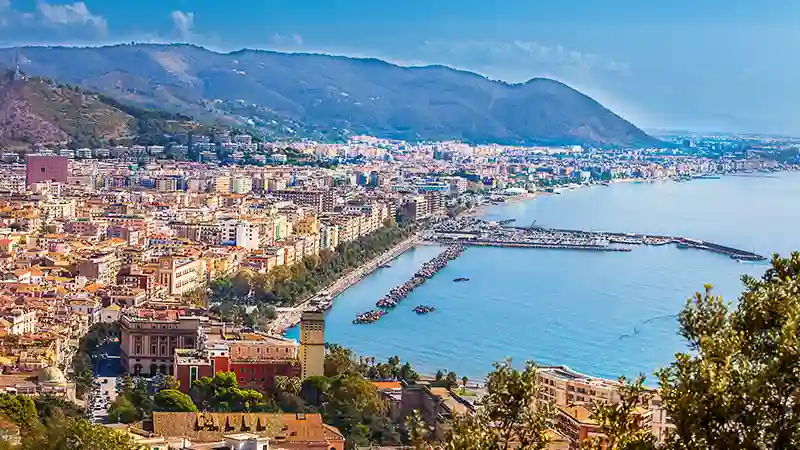Salerno Ferries
Book your next trip!
Find and book ferry tickets to and from Salerno
Find and book ferry tickets to and from Salerno

Salerno boasts 18 ferry routes operated by 13 top-tier ferry companies. Get ready for a convenient sailing experience from Salerno, with schedules perfectly tailored to the seasons, ensuring you always find your ideal departure.
Salerno offers connections to popular routes like Messina - Salerno, Tunis - Salerno, Positano - Salerno. You can customise your trip by choosing between a swift high-speed ferry to get there in a flash or a classic vessel for a more scenic, relaxing journey. From quick local hops to leisurely overnight voyages, your adventure starts here.
Getting to your destination is a breeze with several excellent ferry operators departing regularly from Salerno. You'll find companies like Alicost, NLG, Caronte & Tourist ready to whisk you away.
Each offers a variety of onboard amenities to make your journey pleasant, from comfortable seating and delicious food and drink options to private cabins and even vehicle transport.
With a range of ticket options available depending on the company and vessel, there's something to suit everyone, whether you're traveling solo, with family, or on a business trip.
Whether you're dreaming of an escape, making your way back to the comfort of home, or embarking on a brand-new journey, your perfect voyage begins right here with Salerno.
Route Overview
Route Overview
Operators
Routes
Date Updated: 2025
Reaching Salerno's Shores
Reaching Salerno's Shores
Salerno is well-connected to major Italian cities via the country's extensive rail network, with high-speed trains from Rome arriving in just 2 hours and Naples in under an hour. If traveling by car, the A3 motorway provides direct access to the city, with several parking facilities available near the ferry terminal. For international travelers, Naples International Airport is the closest major air hub, approximately 50 kilometers away, with regular bus services connecting to Salerno. The city's ferry terminal is conveniently located along the waterfront, within walking distance of the historic center and well-served by local buses and taxis from the train station.
Popular Routes
Popular Routes
Salerno: Gateway to the Amalfi Coast
Salerno: Gateway to the Amalfi Coast
Nestled where the Amalfi Coast begins and the Cilento stretches southward, Salerno offers travelers a perfect blend of authentic Italian life and stunning coastal beauty. This historic port city combines medieval architecture with a vibrant waterfront promenade, making it both a destination in its own right and a strategic ferry hub. As you disembark in Salerno, you'll be greeted by the sight of pastel buildings climbing gentle hills, with the scent of lemon groves and sea salt mingling in the Mediterranean breeze.
When to Experience Salerno at Its Finest
When to Experience Salerno at Its Finest
The ideal time to visit Salerno falls between April and June or September to October, when temperatures hover pleasantly between 18-27°C and the summer crowds have yet to arrive or have already departed. July and August bring hot weather and Italian holidaymakers, though the sea breeze offers welcome relief from the heat. Winter in Salerno is mild but can be rainy, though it showcases the spectacular 'Luci d'Artista' light festival from November through January, transforming the city into a magical display. Ferry services operate year-round but increase in frequency during summer months, with more connections to coastal destinations and nearby islands.
Ferries to and from Salerno
Ferries to and from Salerno
Island Adventures and Coastal Gems from Salerno
Island Adventures and Coastal Gems from Salerno
Salerno serves as an excellent jumping-off point for exploring the treasures of the Tyrrhenian Sea. The famed island of Capri is accessible by high-speed ferry in approximately 1 hour, offering visitors its famous Blue Grotto and luxurious atmosphere. The colorful villages of the Amalfi Coast, including Positano and Amalfi itself, can be reached in 35-70 minutes, providing a more relaxed alternative to the crowded coastal roads. For those seeking less touristed destinations, ferries also connect to the beautiful Cilento Coast with its pristine beaches and Greek ruins at Paestum. The summer months even offer special scenic routes that showcase the dramatic coastline from the water, revealing hidden coves and breathtaking cliffs inaccessible by land.
Maritime Heritage and Mediterranean Charm
Maritime Heritage and Mediterranean Charm
Salerno rewards visitors with experiences that blend history, culture, and coastal beauty. Start by wandering the narrow streets of the medieval quarter, where the impressive 11th-century Duomo houses the tomb of Saint Matthew in a crypt adorned with Baroque splendor. The Lungomare Trieste, Salerno's palm-lined seafront promenade, offers perfect views across the Gulf of Salerno and makes for a delightful evening passeggiata among locals. Culinary explorers should sample the local specialty scialatielli ai frutti di mare (fresh pasta with seafood) or pizza from wood-fired ovens, best enjoyed with a glass of local Fiano di Avellino wine. For a deeper connection to the region's maritime traditions, visit the Provincial Archaeological Museum with its collection of artifacts from ancient Greek settlements that once thrived along these shores.
Salerno's Surprising Maritime Tales
Salerno's Surprising Maritime Tales
Salerno holds the distinction of being home to Europe's first medical school, founded in the 9th century, where Arabic medical knowledge was first introduced to Western Europe. The city's port played a pivotal role in Operation Avalanche during WWII, when Allied forces launched the Italian campaign with a massive amphibious landing in 1943. Maritime trade has shaped Salerno for millennia, with evidence that Etruscan sailors used the natural harbor as far back as the 6th century BCE. Perhaps most intriguingly, local fishermen still practice ancient fishing techniques passed down through generations, using methods that have remained largely unchanged since Roman times.
FAQs
FAQs








